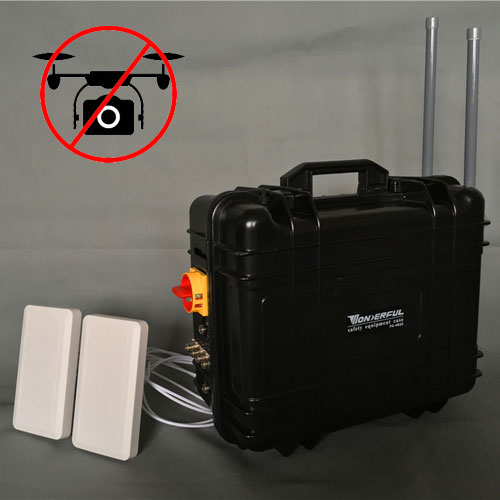The drone jammer device consists of a handheld host and a battery pack. The handheld host is a three-band transmitter antenna integrated design, which can simultaneously generate 2.4GHz/5.8GHz frequency UAV flight control interference signals and satellite positioning interference signals, through the UAV's uplink flight control channel and satellite positioning channel. Blocking interference causes it to lose flight control commands and satellite positioning information, making it unable to fly normally. Depending on the design of the UAV, it will have the control effect of returning, landing and falling.
In the offensive and defensive situation, there is usually a certain distance between the drone operator and the sensitive area that needs to be fortified. The drone took off from the vicinity of the manipulator, and then gradually flew towards the fortified area. When the drone arrives near the fortified area and can carry out effective reconnaissance or sabotage activities, the distance from the drone to the fortified area is usually much closer than its distance to the manipulator.

In the above situation, all uplink signals sent by the operator (sent from the ground to the drone) will be relatively weak due to the long distance. With the same power, because the defender is closer to the drone, the signal will be stronger than the manipulator. The downlink signal received by the defender will also be stronger than that of the manipulator. But the defensive goal of the downlink signal is to prevent the operator from receiving it. At this time, the distance from the drone to the operator is about the same as the distance from the defender to the operator. Therefore, the blocking of the downlink signal does not have a topographical advantage.
It can be seen from the above analysis that it is more advantageous to interfere with the uplink signal. It happens that the uplink signal is usually a remote control signal, which is directly related to the control of the drone. If the uplink signal is interfered, the drone will lose immediate control and can only operate according to the steps preset by the program (usually landing or hovering). The downlink signals are mainly telemetry and images. Although there may be sensitive information, it is not so important compared to the control signal. In addition, the defender has no advantage in the situation and usually takes a laissez-faire attitude towards the downlink signal.
GPS relies on medium orbit satellites. Generally speaking, the signal reaches the surface of the earth after tens of thousands of kilometers, which is already very weak. Therefore, it is easier to interfere with GPS signals when the UAV is very close to the defender. If you want to deceive it, you need to use more complicated means to simulate GPS satellites, which is much more difficult.
Signal interference
At present, the control of UAVs mostly uses radio communication technology. By transmitting high-power interference signals to the target UAVs and suppressing the control signals, the UAVs can be forced to land or return on their own.
Our company uses this principle to develop a gun-shaped UAV jammer. This gun is equipped with an electronic jammer on the frame of the rifle. Once the trigger is pulled, the jammer will transmit a full-band jamming signal to the UAV, so that the UAV is out of the control of the operator and cannot receive the control signal. Automatically land to the ground.
Once the UAV’s signal is in a state of confusion, it usually has 3 options: drop to the ground, return to the operator or descend smoothly. The effective range of this rifle reaches 500-2000 meters.
